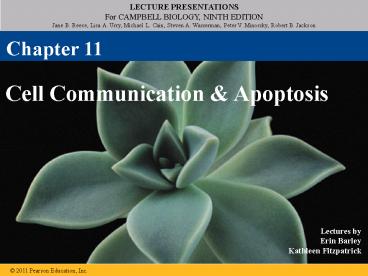Cell Communication - PowerPoint PPT Presentation
1 / 28
Title:
Cell Communication
Description:
Chapter 11 Cell Communication & Apoptosis – PowerPoint PPT presentation
Number of Views:140
Avg rating:3.0/5.0
Title: Cell Communication
1
Chapter 11
Cell Communication Apoptosis
2
Cancer Cell Cycle Control
- Checkpoints Molecular Stop or Go signals
- At G1, G2 (Interphase)
- And M phases of
- The cell either
- Stops and goes into G0 or
- Goes and continues on the cell cycle.
- Molecules that do this signaling include protein
kinases (cyclin-dependent kinases)
3
Images to consider
Cell signaling
Apoptosis
4
(No Transcript)
5
How do chemical control systems work?
- CdK control is similar to other control systems
in the cell. - How do cells communicate?
- How do messages reach cells?
6
Overview Cellular Messaging
- Cell-to-cell communication in multicellular and
unicellular organisms - Universal mechanisms of cellular regulation
(evolutionary connectiveness) - Chemical signals are the most frequent type
- Ex) the fight-or-flight response is triggered by
a signaling molecule called epinephrine
7
Figure 11.1
8
Epinephrine Fight or flight
- Epinephrine (hormone, a.k.a. adrenaline) binds to
a receptor in liver cells - A signal transduction pathway occurs
- The response is the breakdown of glycogen in the
liver cells into glucose - The released energy makes fight or flight
possible.
9
11.1 Local (close) Signaling
- Chemical messengers
- Cell junctions directly connect the cytoplasm of
adjacent cells - Gap junctions in animals
- Plasmodesmata in plants
- Direct contact or cell to cell recognition
- Local regulators, messenger molecules that travel
only short distances
10
Figure 11.4
Plasma membranes
Gap junctionsbetween animal cells
Plasmodesmatabetween plant cells
(a) Cell junctions
(b) Cell-cell recognition
11
Figure 11.5a
Local signaling
Target cell
Electrical signalalong nerve celltriggers
release ofneurotransmitter.
Neurotransmitter diffuses across synapse.
Secretingcell
Secretoryvesicle
Local regulatordiffuses throughextracellular
fluid.
Target cellis stimulated.
(a) Paracrine signaling
(b) Synaptic signaling
12
Long distance signaling
- Plants and animals use chemicals called hormones
- A cells response is determined by whether or not
it has a receptor specific to that signal
13
Figure 11.5b
Long-distance signaling
Endocrine cell
Bloodvessel
Hormone travelsin bloodstream.
Target cellspecificallybinds hormone.
(c) Endocrine (hormonal) signaling
14
11.1 The Three Stages of Cell Signaling A
Preview
- Cells receiving signals go through three
processes - Reception
- Transduction
- Response
Animation Overview of Cell Signaling
15
Figure 11.6-3
3 Stages of Cell Signaling
EXTRACELLULARFLUID
CYTOPLASM
Plasma membrane
Response
Reception
Transduction
Receptor
Activationof cellularresponse
Relay molecules in a signal transductionpathway
Signalingmolecule
Signal-transduction pathway The multiple steps
that convert a signal into a cellular response
16
Concept 11.2 Reception
- Target cell receives the message via a receptor
protein (usually found in the plasma membrane,)
making a ligand. - Ligand the combination of the signal molecule
the receptor protein.
17
Figure 11.7d
Gate closed
Gate closed
Ions
Gate open
Signalingmolecule (ligand)
Plasmamembrane
Ligand-gatedion channel receptor
Cellularresponse
18
Transduction
- Signal transduction pathwaymultiple steps to
relay the signal as (mostly through
proteins-protein kinases, can be cAMP or Ca2
ions) - Analogy falling dominoes
- the receptor activates another protein, which
activates another, and so on, until the protein
producing the response is activated
19
Figure 11.12
First messenger(signaling moleculesuch as
epinephrine)
Adenylylcyclase
G protein
GTP
G protein-coupledreceptor
ATP
Second messenger
cAMP
Proteinkinase A
Cellular responses
20
Response
- Varied, examples include
- Turn on or off genes (triggering protein
synthesis) - Open or close ion channels
- Cell division
21
Figure 11.15
Growth factor
Reception
Receptor
Phosphorylationcascade
Transduction
CYTOPLASM
Inactivetranscriptionfactor
Activetranscriptionfactor
Response
P
DNA
Gene
NUCLEUS
mRNA
22
Figure 11.16
Reception
Binding of epinephrine to G protein-coupled
receptor (1 molecule)
Transduction
Inactive G protein
Active G protein (102 molecules)
Inactive adenylyl cyclase
Active adenylyl cyclase (102)
ATP
Cyclic AMP (104)
Inactive protein kinase A
Active protein kinase A (104)
Inactive phosphorylase kinase
Active phosphorylase kinase (105)
Inactive glycogen phosphorylase
Active glycogen phosphorylase (106)
Response
Glycogen
Glucose 1-phosphate (108 molecules)
23
Figure 11.18
Signalingmolecule
Receptor
Relay molecules
Activationor inhibition
Response 2
Response 3
Response 4
Response 5
Response 1
Cell A. Pathway leadsto a single response.
Cell B. Pathway branches,leading to two
responses.
Cell C. Cross-talk occursbetween two pathways.
Cell D. Different receptorleads to a
differentresponse.
24
Concept 11.5 Apoptosis
- Apoptosisprogrammed or controlled cell suicide
- Cell parts chopped up/ packaged into vesicles
digested by scavenger cells - Apoptosis prevents enzymes from leaking out of a
dying cell and damaging neighboring cells
25
Figure 11.20
Apoptosis of a human white blood cell.
2 ?m
26
Triggers Method
- Triggered by
- An extracellular death-signaling ligand
- DNA damage in the nucleus
- Protein misfolding in the endoplasmic reticulum
- Caspasesenzymes that cut up proteins (they carry
out apoptosis.)
27
Evolution Importance of Apoptosis
- Evolved early in animal evolution
- essential for the development and maintenance of
all animals (ex. making fingers) - Diseases (Possible links)
- Parkinsons and Alzheimers
- Lack of apoptosis may contribute to some cancers
28
Figure 11.22
Cells undergoingapoptosis
Space betweendigits
1 mm
Interdigital tissue































